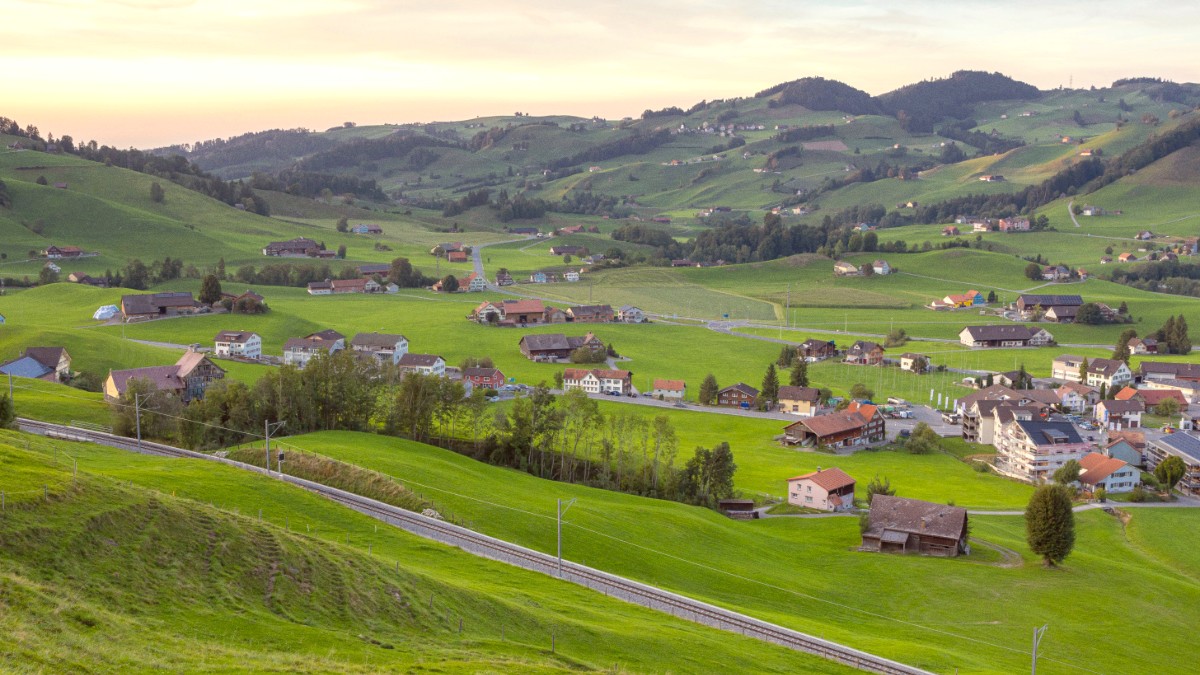
Switzerland
Appenzeller food is hearty, rustic, and designed for sustenance. Its history ties to dairy farming and the alpine economy. Many dishes developed from the need to preserve food through fermentation or drying.
Ingredients: Appenzeller Käse (cheese) holds supreme importance. Dairy products, beef, pork (often cured), potatoes, bread, and local herbs are fundamental. Flavors are typically savory, rich, and spiced with herbs.
Typically served between 7:00 AM and 9:00 AM. It includes bread, local cheese, cold cuts, muesli, yogurt, and coffee or tea.
Usually from 12:00 PM to 1:30 PM. Lunch frequently presents a substantial meal, especially in restaurants presenting "Mittagsmenu" (lunch specials).
Typically eaten earlier than in some Southern European countries, usually between 6:00 PM and 9:00 PM. Reservations are recommended for dinner, especially on weekends or in popular establishments.
The region's most celebrated culinary export. This hard, aromatic cheese comes from raw cow's milk, distinguished by a secret herbal brine wash during aging. Its flavor varies from mild to tangy. Find it everywhere: in cheese shops, on breakfast buffets, in traditional dishes, and as a popular souvenir.
A hallmark of Appenzell's culinary heritage.
Switzerland's answer to macaroni and cheese. This hearty Alpine dish combines macaroni with Appenzeller cheese, potatoes, and caramelized onions. Frequently served with applesauce, it presents a sweet contrast to the savory dish.
A comforting and filling mountain meal.
Mostbröckli is air-dried, cured beef or pork, thinly sliced, a popular appetizer. Appenzeller Siedwurst is a boiled sausage, a comforting staple, often served with Käshörnli or Hörnli und Ghackets (macaroni with minced meat and gravy).
Essential local meats for a true Appenzeller taste.
Creamy milk caramels are a sweet treat. Birnbrot (Pear Bread) is a sweet bread with dried pears, nuts, and spices, often enjoyed with coffee.
Game dishes, like deer or wild boar, are common in autumn. Local village festivals feature traditional Appenzeller foods and drinks, especially during the "Alpabfahrt" (cattle descent) in autumn.
Limited compared to major cities, but found in higher-end hotels in Appenzell town or nearby Weissbad and Gontenbad. These restaurants focus on elevated regional Swiss and Appenzeller cuisine, utilizing high-quality local ingredients. Reservations are recommended.
Abundant in Appenzell village and surrounding towns like Gais and Urnäsch. These present traditional Swiss and Appenzeller dishes in comfortable, often traditional settings. Many hotels also run good mid-range restaurants welcoming non-guests. This is where you find authentic local cuisine.
Supermarkets like Coop and Migros present a wide grocery selection, including fresh produce, bread, cheese, and ready-made sandwiches for picnics or self-catering. Local bakeries sell affordable sandwiches, pastries, and traditional breads like "Appenzeller Biberli". Smaller village inns may present simpler, more affordable meals.
International cuisine options are limited in Appenzell. The focus remains mainly on Swiss and traditional Appenzeller dishes.
Some restaurants might present a few Italian dishes (like pasta or pizza) or other general European options.
Expect a wide range of local specialties, but not a broad array of global cuisines.
For extensive international dining, larger cities like Zurich or St. Gallen are nearby.
Ideal for coffee and pastries.
Sample fresh, local cheeses.
Experience local ambiance.
Quiet settings, local dishes.
The best approach involves speaking directly with restaurant staff. If a language barrier presents, use a Translation app to explain your needs clearly.
Learning German phrases related to your allergy (e.g., "Ich habe eine Glutenallergie") may prove useful.
Some restaurants now label common allergens, but this is not universal. For strict dietary needs, renting a vacation apartment with kitchen facilities and purchasing groceries from supermarkets (which often label allergens) provides the most control. Consider packing Allergy-friendly snacks.
Supermarkets are your ally for managing specific diets.
When dining out is challenging, grocery stores present many options for fresh ingredients and packaged foods. Many local farm shops also sell organic and locally sourced products that cater to specific preferences.
Many chefs are willing to adapt dishes upon request, notably for simpler modifications like omitting cheese or a specific ingredient. Communication is to a satisfying dining experience. Be specific about your needs.
Formal cooking classes focusing on Appenzeller cuisine are limited. However, some local farms or cheese dairies may present private tours or demonstrations of their production processes by arrangement.
Located in Stein AR, observe the production of famous Appenzeller cheese through large viewing windows. Interactive exhibits clarify the cheese-making process. The facility includes a restaurant and shop.
Throughout the Appenzell countryside, numerous local farms run small shops (Hofladen) where they sell their own produce, cheese, dried meats, schnapps, and other homemade goods directly.
Autumn brings game dishes like deer or wild boar to restaurant menus, reflecting the hunting season. These seasonal additions enrich the dining landscape.
Look for local recommendations during your visit.
Beyond major festivals, smaller village events frequently include food stalls and opportunities to sample a variety of regional specialties, providing a cultural experience.
Check with the local tourist office for event listings.
Apple cider, both alcoholic and non-alcoholic, reflects the region's fruit farming traditions, offering a refreshing local drink.
The region's herbal liquors, like Sämtiswasser and Appenzeller Alpenbitter, underscore a long history of utilizing local herbs.
Appenzeller cuisine embodies the region's self-sufficiency and the hard work of its farmers and mountain dwellers.
Many establishments prioritize local sourcing.